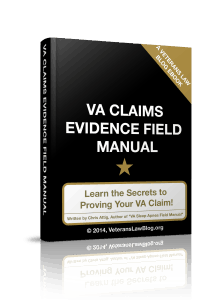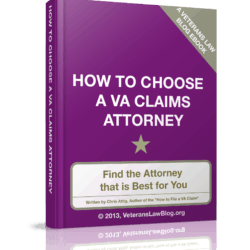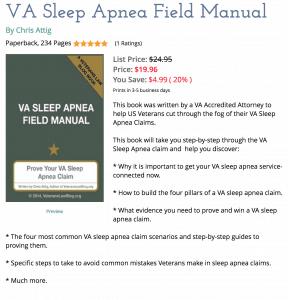I’ve talk a lot about lay evidence on the Veterans Law Blog®. In just about every VA claim – including the VA TDIU claim – lay evidence has a a pure raw power that is hard to rival.
Today, I want to give you some tips for using Lay Evidence in a TDIU Claim.
But first, let’s start with a quick refresher.
What is a VA TDIU Claim?
Let’s be clear from the start: a VA TDIU claim is not a claim about being unemployed. It is about being unemployable.
The whole idea behind VA disability compensation is that it is supposed to compensate veterans when a service connected disability impairs the veteran’s earning capacity.
The VA has a duty to maximize the veteran’s compensation to reduce as much as possible that impairment on earning capacity.
The first thing they do is determine an impairment rating based on the schedule of VA disability ratings. (The so-called schedular rating).
What happens from there turns on the facts of the case.
When the schedular rating reaches certain levels (60% for a single condition, or 70% for multiple conditions with one rated at least 40%, the so-called 60/70-40 rule) or when the veteran produces “cogent evidence” that a service connected disability interferes with his or her ability to get or keep substantially gainful employment, the veteran has raised a VA TDIU Claim.
If the veteran can prove, typically with a combination of lay, medical and testimony of a vocational rehabilitation expert, that they are unable to get or keep substantially gainful employment due to their service-connected disability, then they are entitled to a rating of 100% – also known as the TDIU rating (Totally Disabled based on Individual Unemployability).
So, as you can see, the strength of the lay, medical and vocational expert evidence is what often makes or breaks a VA TDIU claim.
I’ve got other posts on the Veterans Law Blog® that talk to you about finding the right vocational expert for your VA TDIU claim, but let’s talk a little about using lay evidence to help bolster that claim.
5 Tips for Using Lay Evidence in a VA TDIU Claim or Appeal.
Here are 5 tips to help you:
1) Load your TDIU Claim with 5-Star Lay evidence.
Lay evidence is powerful, because favorable lay evidence requires that the VA and BVA address it specifically in their decision. The more favorable lay evidence you have, the harder it becomes to deny your claim.
Work to make sure that the Lay Evidence is submitted on a Form other than VA Form 21-4138. This VA form is absolutely worthless for submitting evidence, if you ask me.
I use the Sworn Declaration – so my clients don’t even have to pay for a notary. (I’ve added this Form – and a couple worksheets) to the VA TDIU eBook – see below for more information).
What types of Lay Evidence should you include in your C-File?
a) lay evidence that demonstrates where the symptoms appear in your daily life. If you experience the symptoms of your condition at work, have a witness who has observed those symptoms tell about it in a Sworn Declaration.
b) lay evidence showing the daily limitations you face from your service-connected disability (problems walking, sitting, standing, eating, breathing, talking, communicating with others, lifting, twisting, turning, carrying, hauling, driving, seeing, hearing – you name it).
What is the difference between a symptom and a limitation? Symptoms are those things that tell you – and those around you – that you have a specific medical condition. Limitations are the things that you cannot do because of your medical condition.
In a VA TDIU claim, this lay evidence should focus on the tasks you would typically be required to do on the typical job.
This includes more than just the job-related tasks, however.
You should be sure to include lay evidence of your ability to attend work and your ability to function in the work-environment.
For example, if you are an auto-mechanic, and your hearing loss is so significant that you cannot work in a garage because the noise threatens your safety and your co-worker’s safety, you could make a persuasive argument to this effect with lay evidence that give specific examples of how hearing loss has/is/would effect you in the workplace.
Likewise, if you are a school-teacher, and have prostrating migraines regularly each morning, it is going to be difficult for you to attend work because of your disability. Lay evidence from yourself, your colleagues, your supervisor (past or present) can establish this in your VA TDIU claim.
Keep in mind, lay evidence is more than just your testimony. Lay evidence can come from anyone – it can include the testimony of the people who observe you in the workplace, who observe your symptoms, or who observe both. And lay evidence is not always testimony. If you have a supervisor’s performance review documenting that one employer accommodated your disability in the workplace, that too is lay evidence as well.
2) Lay evidence Works Best When Used in Conjunction with Medical Evidence.
Medical Evidence is the rifle that puts the Lay Evidence on “target”. By themselves, lay and medical evidence can be strong or weak.
Together, they are like a shot of B-complex for the VA TDIU claim.
Why?
The only way that the VA can reject lay or medical evidence is to show that it is not relevant, competent, or credible (or otherwise lacks one of the 5 stars of evidence).
Subscribers to the Veterans Law Blog® get FREE access to the VA Claims Evidence Field Manual. This is an ebook that will walk you through the different types of evidence in a VA Claim and how to use them.
If you are a Veterans Law Blog® subscriber, simply click here (or go to your downloads tab) on your “My Account” page to download the VA Claims Evidence Field Manual
If you are not a Veterans Law Blog® subscriber, the only way to get access to the VA Claims Evidence Field Manual is to click here and subscribe.
This is hard to do.
Though the BVA routinely finds that veterans or their evidence lacks credibility, they are not often affirmed on these decisions.
Once you wrap medical and lay evidence into a medical opinion, or in the case of a VA TDIU claim, wrap them into a vocational expert opinion, you are further insulating them from attack.
It’s not that the expert opinion bolsters the strength of the lay evidence, for example. A good expert opinion considers lay evidence and relies on it to reach a conclusion.
To overcome THAT, the VA has to do even more work to find that the expert testimony – and the lay evidence on which it relies – lacks one or more of the 5 stars of evidence.
Bottom line: if strong lay evidence is relied on in a vocational expert opinion, the VA has to work twice as hard to defeat it.
Ultimately, however, my point is this: Lay evidence does NOTHING by itself – it needs medical evidence to have the full effect.
Medical evidence, too, does nothing by itself. Without lay evidence, medical evidence is just a snapshot of the 15 or 30 minutes that he or she was in the C&P Examiner’s office and not the full picture of the Veteran’s condition because it is based on one tiny little aspect of the Veteran’s life.
3) Make sure your statements are specific and clear.
It’s not enough to say that you can’t work and leave the VA to deduce the conclusion. This is burying the needle in the haystack.
I remember reading one C-File for a Veteran seeking TDIU. Here is the full extent of the lay evidence he gave the VA (I’m paraphrasing, but not much).:
“I used to be a tow truck driver. The Vietnam War screwed up my knees, and now I can’t work. I want you to think about how you would be a tow truck driver with knees as bad as mine, and then deny my claim again. I dare you.”
It’s a good point – a great point. I don’t know how you handle all of the work of a tow truck driver with knees as bad as this veteran’s.
But the law doesn’t work on “good points” and “zingers.” Law & Order, Boston Legal, and a host of other TV shows about the law do us a great disservice by suggesting that the side that gets the best “one-line” zinger wins.
Want your Lay Evidence to matter in your VA TDIU Claim?
Make sure that it pertains to one of the 4 Pillars of the VA Claim, and use a Sworn Declaration form that actually carries weight.
4) Know your Role in the TDIU Claims Process.
One of the most important cases in veterans law is the Jandreau case.
Jandreau says that lay evidence is competent to identify symptomatology of a condition – and a bunch of other things – it does not give a lay person the power to express a professional medical opinion.
Here is the Veteran’s job in a TDIU Claim – or any VA Disability Claim for that matter:
Your job is to describe and document the symptoms of your service-connected conditions, and the daily limitations you face because of them.
Your job is to make sure that the evidence you submit in your VA Claim is 5-Star Evidence.
Your job is to make sure that you submit ENOUGH 5-Star Evidence in your VA Claim.
It’s the vocational expert’s job is to explain how those symptoms and limitations keep you from getting or keeping substantially gainful employment.
It’s THAT simple.
5) Be patient – and DO IT RIGHT the FIRST TIME.
Barking at, and lecturing, VA employees and C&P examiners is easy.
Anyone can do it.
The problem is, barking at VA employees doesn’t help your claim. Nor does good old-fashioned “arse-kissing. You know what does work?
Here are 3 things:
→ Don’t Be a Hater.
Your frustration with the VA Claims Process is legitimate. You have every right to be angry – to feel betrayed.
That said, see if you can set aside the rancor and hatred of a VBA bureaucracy that is maddeningly complex and infuriatingly slow, and treat the VA employees with civility – whether you like them or not.
I struggled with the same anger, frustration and betrayal that you did.
And it damn near caused me to give up my law practice more than once. But then I realized that if I focused on finding the 1 person that would help me, I could suffer through the 25 bone-heads that only “talk-the-talk” when it comes to supporting Veterans.
→ Help the VA to Help You.
Take a step back, realize that 2 things that the VA and BVA struggles with the most are:
1) the TDIU claim, and
2) lay evidence.
Stay objective, follow the steps in the TDIU Field Manuals, and learn to HELP the VA understand the evidence by writing more persuasive claims.
→ File Your TDIU Claim the RIGHT Way – from the Start.
I had an NCO that used to say this to the new boots that came in our unit: “It’s easier to avoid doing Stupid Shit than it is to unkill yourself.”
While a VA TDIU claim is not life and death, the saying applies with equal force: learn how to build your claim the right way – the first time.
Subscribers to the Veterans Law Blog® get free access to the VA TDIU Manual. This is an ebook that will walk you through the filing, proving and (hopefully) winning a VA TDIU Claim.
If you are a Veterans Law Blog® subscriber, simply click here (or go to your downloads tab) on your “My Account” page to download the VA TDIU Field Manual
If you are not a Veterans Law Blog® subscriber, the only way to get access to the VA TDIU Field Manual is to click here and subscribe.









Regional office has my remanded appeal for a decision and thy r giving me the run a round
Calvin,
Thanks for your comment – an upcoming post on the Veterans Law Blog will address remands, including my philosophy of “Don’t Fear the Remand”…
Help me figure out how I can give Veterans the BEST info about the Remand Process – how are they giving you the run-around?
Is it your actual Regional Office, or did the BVA remand it to the Appeals Management Center?
You can post here, or if you are more comfortable, send me a “Mail Call Submission” and I’ll respond on the Veterans Law Blog.
— Chris